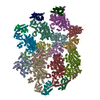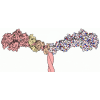[English] 日本語
 Yorodumi
Yorodumi- PDB-6bnv: CryoEM structure of MyosinVI-actin complex in the rigor (nucleoti... -
+ Open data
Open data
- Basic information
Basic information
| Entry | Database: PDB / ID: 6bnv | ||||||
|---|---|---|---|---|---|---|---|
| Title | CryoEM structure of MyosinVI-actin complex in the rigor (nucleotide-free) state, backbone-averaged with side chains truncated to alanine | ||||||
 Components Components |
| ||||||
 Keywords Keywords | CONTRACTILE PROTEIN / Cytoskeleton / Filament / complex | ||||||
| Function / homology |  Function and homology information Function and homology informationCH domain binding / regulation of secretion / inner ear auditory receptor cell differentiation / actin filament-based movement / myosin complex / clathrin-coated vesicle / cytoskeletal motor activator activity / inner ear morphogenesis / myosin heavy chain binding / microfilament motor activity ...CH domain binding / regulation of secretion / inner ear auditory receptor cell differentiation / actin filament-based movement / myosin complex / clathrin-coated vesicle / cytoskeletal motor activator activity / inner ear morphogenesis / myosin heavy chain binding / microfilament motor activity / tropomyosin binding / myosin binding / actin filament bundle / troponin I binding / filamentous actin / microvillus / mesenchyme migration / cytoskeletal motor activity / actin filament bundle assembly / skeletal muscle myofibril / striated muscle thin filament / skeletal muscle thin filament assembly / actin monomer binding / skeletal muscle fiber development / stress fiber / titin binding / ruffle / clathrin-coated pit / actin filament polymerization / actin filament organization / actin filament / filopodium / DNA damage response, signal transduction by p53 class mediator / intracellular protein transport / sensory perception of sound / ADP binding / Hydrolases; Acting on acid anhydrides; Acting on acid anhydrides to facilitate cellular and subcellular movement / ruffle membrane / endocytosis / disordered domain specific binding / calcium-dependent protein binding / actin filament binding / intracellular protein localization / protein transport / myelin sheath / lamellipodium / actin cytoskeleton / cell body / cytoplasmic vesicle / cell cortex / nuclear membrane / calmodulin binding / hydrolase activity / protein domain specific binding / calcium ion binding / centrosome / positive regulation of gene expression / perinuclear region of cytoplasm / magnesium ion binding / Golgi apparatus / protein-containing complex / nucleoplasm / ATP binding / metal ion binding / identical protein binding / nucleus / plasma membrane / cytoplasm / cytosol Similarity search - Function | ||||||
| Biological species |    | ||||||
| Method | ELECTRON MICROSCOPY / helical reconstruction / cryo EM / Resolution: 4.6 Å | ||||||
 Authors Authors | Gurel, P.S. / Alushin, G.A. | ||||||
| Funding support |  United States, 1items United States, 1items
| ||||||
 Citation Citation |  Journal: Elife / Year: 2017 Journal: Elife / Year: 2017Title: Cryo-EM structures reveal specialization at the myosin VI-actin interface and a mechanism of force sensitivity. Authors: Pinar S Gurel / Laura Y Kim / Paul V Ruijgrok / Tosan Omabegho / Zev Bryant / Gregory M Alushin /  Abstract: Despite extensive scrutiny of the myosin superfamily, the lack of high-resolution structures of actin-bound states has prevented a complete description of its mechanochemical cycle and limited ...Despite extensive scrutiny of the myosin superfamily, the lack of high-resolution structures of actin-bound states has prevented a complete description of its mechanochemical cycle and limited insight into how sequence and structural diversification of the motor domain gives rise to specialized functional properties. Here we present cryo-EM structures of the unique minus-end directed myosin VI motor domain in rigor (4.6 Å) and Mg-ADP (5.5 Å) states bound to F-actin. Comparison to the myosin IIC-F-actin rigor complex reveals an almost complete lack of conservation of residues at the actin-myosin interface despite preservation of the primary sequence regions composing it, suggesting an evolutionary path for motor specialization. Additionally, analysis of the transition from ADP to rigor provides a structural rationale for force sensitivity in this step of the mechanochemical cycle. Finally, we observe reciprocal rearrangements in actin and myosin accompanying the transition between these states, supporting a role for actin structural plasticity during force generation by myosin VI. #1: Journal: Nat Nanotechnol / Year: 2018 Title: Controllable molecular motors engineered from myosin and RNA. Authors: Tosan Omabegho / Pinar S Gurel / Clarence Y Cheng / Laura Y Kim / Paul V Ruijgrok / Rhiju Das / Gregory M Alushin / Zev Bryant /  Abstract: Engineering biomolecular motors can provide direct tests of structure-function relationships and customized components for controlling molecular transport in artificial systems or in living cells . ...Engineering biomolecular motors can provide direct tests of structure-function relationships and customized components for controlling molecular transport in artificial systems or in living cells . Previously, synthetic nucleic acid motors and modified natural protein motors have been developed in separate complementary strategies to achieve tunable and controllable motor function. Integrating protein and nucleic-acid components to form engineered nucleoprotein motors may enable additional sophisticated functionalities. However, this potential has only begun to be explored in pioneering work harnessing DNA scaffolds to dictate the spacing, number and composition of tethered protein motors . Here, we describe myosin motors that incorporate RNA lever arms, forming hybrid assemblies in which conformational changes in the protein motor domain are amplified and redirected by nucleic acid structures. The RNA lever arm geometry determines the speed and direction of motor transport and can be dynamically controlled using programmed transitions in the lever arm structure . We have characterized the hybrid motors using in vitro motility assays, single-molecule tracking, cryo-electron microscopy and structural probing . Our designs include nucleoprotein motors that reversibly change direction in response to oligonucleotides that drive strand-displacement reactions. In multimeric assemblies, the controllable motors walk processively along actin filaments at speeds of 10-20 nm s. Finally, to illustrate the potential for multiplexed addressable control, we demonstrate sequence-specific responses of RNA variants to oligonucleotide signals. | ||||||
| History |
|
- Structure visualization
Structure visualization
| Movie |
 Movie viewer Movie viewer |
|---|---|
| Structure viewer | Molecule:  Molmil Molmil Jmol/JSmol Jmol/JSmol |
- Downloads & links
Downloads & links
- Download
Download
| PDBx/mmCIF format |  6bnv.cif.gz 6bnv.cif.gz | 1.1 MB | Display |  PDBx/mmCIF format PDBx/mmCIF format |
|---|---|---|---|---|
| PDB format |  pdb6bnv.ent.gz pdb6bnv.ent.gz | 755.5 KB | Display |  PDB format PDB format |
| PDBx/mmJSON format |  6bnv.json.gz 6bnv.json.gz | Tree view |  PDBx/mmJSON format PDBx/mmJSON format | |
| Others |  Other downloads Other downloads |
-Validation report
| Summary document |  6bnv_validation.pdf.gz 6bnv_validation.pdf.gz | 1.2 MB | Display |  wwPDB validaton report wwPDB validaton report |
|---|---|---|---|---|
| Full document |  6bnv_full_validation.pdf.gz 6bnv_full_validation.pdf.gz | 1.4 MB | Display | |
| Data in XML |  6bnv_validation.xml.gz 6bnv_validation.xml.gz | 201.9 KB | Display | |
| Data in CIF |  6bnv_validation.cif.gz 6bnv_validation.cif.gz | 309.9 KB | Display | |
| Arichive directory |  https://data.pdbj.org/pub/pdb/validation_reports/bn/6bnv https://data.pdbj.org/pub/pdb/validation_reports/bn/6bnv ftp://data.pdbj.org/pub/pdb/validation_reports/bn/6bnv ftp://data.pdbj.org/pub/pdb/validation_reports/bn/6bnv | HTTPS FTP |
-Related structure data
| Related structure data |  7116MC  7115C  7117C  6bnoC  6bnpC  6bnqC  6bnuC  6bnwC C: citing same article ( M: map data used to model this data |
|---|---|
| Similar structure data |
- Links
Links
- Assembly
Assembly
| Deposited unit | 
|
|---|---|
| 1 |
|
- Components
Components
| #1: Protein | Mass: 93207.297 Da / Num. of mol.: 6 Source method: isolated from a genetically manipulated source Source: (gene. exp.)   #2: Protein | Mass: 41560.266 Da / Num. of mol.: 8 / Source method: isolated from a natural source / Source: (natural)  #3: Protein | Mass: 16406.004 Da / Num. of mol.: 6 Source method: isolated from a genetically manipulated source Source: (gene. exp.)   |
|---|
-Experimental details
-Experiment
| Experiment | Method: ELECTRON MICROSCOPY |
|---|---|
| EM experiment | Aggregation state: FILAMENT / 3D reconstruction method: helical reconstruction |
- Sample preparation
Sample preparation
| Component |
| ||||||||||||||||||||||||||||||||||||||||||||||||||
|---|---|---|---|---|---|---|---|---|---|---|---|---|---|---|---|---|---|---|---|---|---|---|---|---|---|---|---|---|---|---|---|---|---|---|---|---|---|---|---|---|---|---|---|---|---|---|---|---|---|---|---|
| Molecular weight | Value: 0.139 MDa / Experimental value: NO | ||||||||||||||||||||||||||||||||||||||||||||||||||
| Source (natural) |
| ||||||||||||||||||||||||||||||||||||||||||||||||||
| Source (recombinant) |
| ||||||||||||||||||||||||||||||||||||||||||||||||||
| Buffer solution | pH: 7.5 Details: Buffer was filtered through 0.44 um filter and degassed. | ||||||||||||||||||||||||||||||||||||||||||||||||||
| Buffer component |
| ||||||||||||||||||||||||||||||||||||||||||||||||||
| Specimen | Conc.: 0.045 mg/ml / Embedding applied: NO / Shadowing applied: NO / Staining applied: NO / Vitrification applied: YES Details: 0.45 mg/mL myosin VI was added to 0.025 mg/mL actin | ||||||||||||||||||||||||||||||||||||||||||||||||||
| Specimen support | Grid material: COPPER / Grid mesh size: 200 divisions/in. / Grid type: C-flat-1.2/1.3 | ||||||||||||||||||||||||||||||||||||||||||||||||||
| Vitrification | Instrument: LEICA EM GP / Cryogen name: ETHANE / Humidity: 95 % / Chamber temperature: 298 K Details: Sample was applied to a glow-discharged holey carbon grid. 3 uL actin was incubated for 60 seconds. 3 uL of myosin VI was added and incubated for 60 seconds. 3 uL solution was removed. An ...Details: Sample was applied to a glow-discharged holey carbon grid. 3 uL actin was incubated for 60 seconds. 3 uL of myosin VI was added and incubated for 60 seconds. 3 uL solution was removed. An additional 3 uL of myosin VI was applied. After 60 seconds, 3 uL solution was removed, and the grid was blotted for 3 seconds from the backside with filter paper. |
- Electron microscopy imaging
Electron microscopy imaging
| Microscopy | Model: FEI TECNAI 20 |
|---|---|
| Electron gun | Electron source:  FIELD EMISSION GUN / Accelerating voltage: 200 kV / Illumination mode: FLOOD BEAM FIELD EMISSION GUN / Accelerating voltage: 200 kV / Illumination mode: FLOOD BEAM |
| Electron lens | Mode: BRIGHT FIELD / Nominal magnification: 29000 X / Nominal defocus max: 3000 nm / Nominal defocus min: 1500 nm / Cs: 2 mm / C2 aperture diameter: 100 µm / Alignment procedure: COMA FREE |
| Specimen holder | Cryogen: NITROGEN Specimen holder model: GATAN 626 SINGLE TILT LIQUID NITROGEN CRYO TRANSFER HOLDER |
| Image recording | Average exposure time: 0.25 sec. / Electron dose: 1.5 e/Å2 / Detector mode: COUNTING / Film or detector model: GATAN K2 SUMMIT (4k x 4k) / Num. of grids imaged: 3 / Num. of real images: 778 |
| Image scans | Sampling size: 5 µm / Width: 3838 / Height: 3711 / Movie frames/image: 24 / Used frames/image: 1-24 |
- Processing
Processing
| EM software |
| ||||||||||||||||||||||||||||||||||||||||||||||||||||||||
|---|---|---|---|---|---|---|---|---|---|---|---|---|---|---|---|---|---|---|---|---|---|---|---|---|---|---|---|---|---|---|---|---|---|---|---|---|---|---|---|---|---|---|---|---|---|---|---|---|---|---|---|---|---|---|---|---|---|
| CTF correction | Type: PHASE FLIPPING AND AMPLITUDE CORRECTION | ||||||||||||||||||||||||||||||||||||||||||||||||||||||||
| Helical symmerty | Angular rotation/subunit: -166.73 ° / Axial rise/subunit: 28.06 Å / Axial symmetry: C1 | ||||||||||||||||||||||||||||||||||||||||||||||||||||||||
| 3D reconstruction | Resolution: 4.6 Å / Resolution method: FSC 0.143 CUT-OFF / Num. of particles: 56116 / Algorithm: FOURIER SPACE / Num. of class averages: 1 / Symmetry type: HELICAL | ||||||||||||||||||||||||||||||||||||||||||||||||||||||||
| Atomic model building | B value: 150 / Protocol: FLEXIBLE FIT / Space: REAL Details: 2BKI chain B was grafted onto Chains A-F of 6BNP, then assembled by rigid body docking into the 7.5 A low pass-filtered density map, followed by flexible fitting with DireX. The resulting ...Details: 2BKI chain B was grafted onto Chains A-F of 6BNP, then assembled by rigid body docking into the 7.5 A low pass-filtered density map, followed by flexible fitting with DireX. The resulting model was subjected to MDFF using the 7.5 A low pass-filtered density map. Atomistic models were backbone-averaged in Phenix and side chains were truncated to alanine. This treatment has resulted in the errors noted in the associated caveats. |
 Movie
Movie Controller
Controller








 PDBj
PDBj






